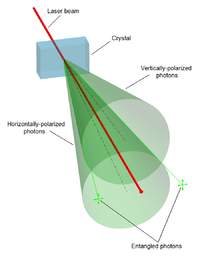
Photo from wikipedia
More to imaging than meets the eye Traditional imaging techniques involve peering down a lens and collecting as much light from the target scene as possible. That requirement can set… Click to show full abstract
More to imaging than meets the eye Traditional imaging techniques involve peering down a lens and collecting as much light from the target scene as possible. That requirement can set limits on what can be seen. Altmann et al. review some of the most recent developments in the field of computational imaging, including full three-dimensional imaging of scenes that are hidden from direct view (e.g., around a corner or behind an obstacle). High-resolution imaging can be achieved with a single-pixel detector at wavelengths for which no cameras currently exist. Such advances will lead to the development of cameras that can see through fog or inside the human body. Science, this issue p. eaat2298 BACKGROUND Imaging technologies, which extend human vision capabilities, are such a natural part of our current everyday experience that we often take them for granted. However, the ability to capture images with new kinds of sensing devices that allow us to see more than what can be seen by the unaided eye has a relatively recent history. In the early 1800s, the first ever photograph was taken: an unassuming picture that required days of exposure to obtain a very grainy image. In the late 1800s, a photograph was used for the first time to see the movement of a running horse that the human eye alone could not see. In the following years, photography played a pivotal role in recording human history, ranging from influencing the creation of the first national parks in the United States all the way to documenting NASA’s Apollo 11 mission to put a man on the Moon. In the 1990s, roughly 10 billion photographs were taken per year. Facilitated by the explosion in internet usage since the 2000s, this year we will approach 2 trillion images per year—nearly 1000 images for every person on the planet. This upsurge is enabled by considerable advances in sensing and data storage and communication. At the same time, it is driving the desire for imaging technology that can further exceed the capabilities of human vision and incorporate higher-level aspects of visual processing. ADVANCES Beyond consumer products, research labs are producing new forms of imaging that look quite different from anything we were used to and, in some cases, do not resemble cameras at all. Light is typically detected at relatively high intensities, in the spectral range and with frame rates comfortable to the human eye. However, emerging technologies are now relying on sensors that can detect just one single photon, the smallest quantum out of which light is made. These detectors provide a “click,” just like a Geiger detector that clicks in the presence of radioactivity. We have now learned to use these “click” detectors to make cameras that have enhanced properties and applications. For example, videos can be created at a trillion frames per second, making a billion-fold jump in speed with respect to standard high-speed cameras. These frame rates are sufficient, for example, to freeze light in motion in the same way that previous photography techniques were able to freeze the motion of a bullet—although light travels a billion times faster than a supersonic bullet. By fusing this high temporal resolution together with single-photon sensitivity and advanced computational analysis techniques, a new generation of imaging devices is emerging, together with an unprecedented technological leap forward and new imaging applications that were previously difficult to imagine. For example, full three-dimensional (3D) images can be taken of a scene that is hidden behind a wall, the location of a person or car can be precisely tracked from behind a corner, or images can be obtained from a few photons transmitted directly through an opaque material. Inspired by quantum techniques, it is also possible to create cameras that have just one pixel or that combine information from multiple sensors, providing images with 3D and spectral information that was not otherwise possible to obtain. OUTLOOK Quantum-inspired imaging techniques combined with computational approaches and artificial intelligence are changing our perspective of what constitutes an image and what can or cannot be imaged. Steady progress is being made in the direction of building cameras that can see through fog or directly inside the human body with groundbreaking potential for self-driving cars and medical diagnosis. Other cameras are being developed that can form 3D images from information with less than one photon per pixel. Single-photon cameras have already made their way into widely sold smartphones where they are currently used for more mundane purposes such as focusing the camera lens or detecting whether the phone is being held close to one’s ear. This technology is already out of the research laboratories and is on the way to delivering fascinating imaging systems. Quantum-based imaging systems are being developed to image through opaque media (e.g., fog or human tissue) that scatter light in all directions. PHOTO: KEVIN J. MITCHELL Computational imaging combines measurement and computational methods with the aim of forming images even when the measurement conditions are weak, few in number, or highly indirect. The recent surge in quantum-inspired imaging sensors, together with a new wave of algorithms allowing on-chip, scalable and robust data processing, has induced an increase of activity with notable results in the domain of low-light flux imaging and sensing. We provide an overview of the major challenges encountered in low-illumination (e.g., ultrafast) imaging and how these problems have recently been addressed for imaging applications in extreme conditions. These methods provide examples of the future imaging solutions to be developed, for which the best results are expected to arise from an efficient codesign of the sensors and data analysis tools.
Journal Title: Science
Year Published: 2018
Link to full text (if available)
Share on Social Media: Sign Up to like & get
recommendations!